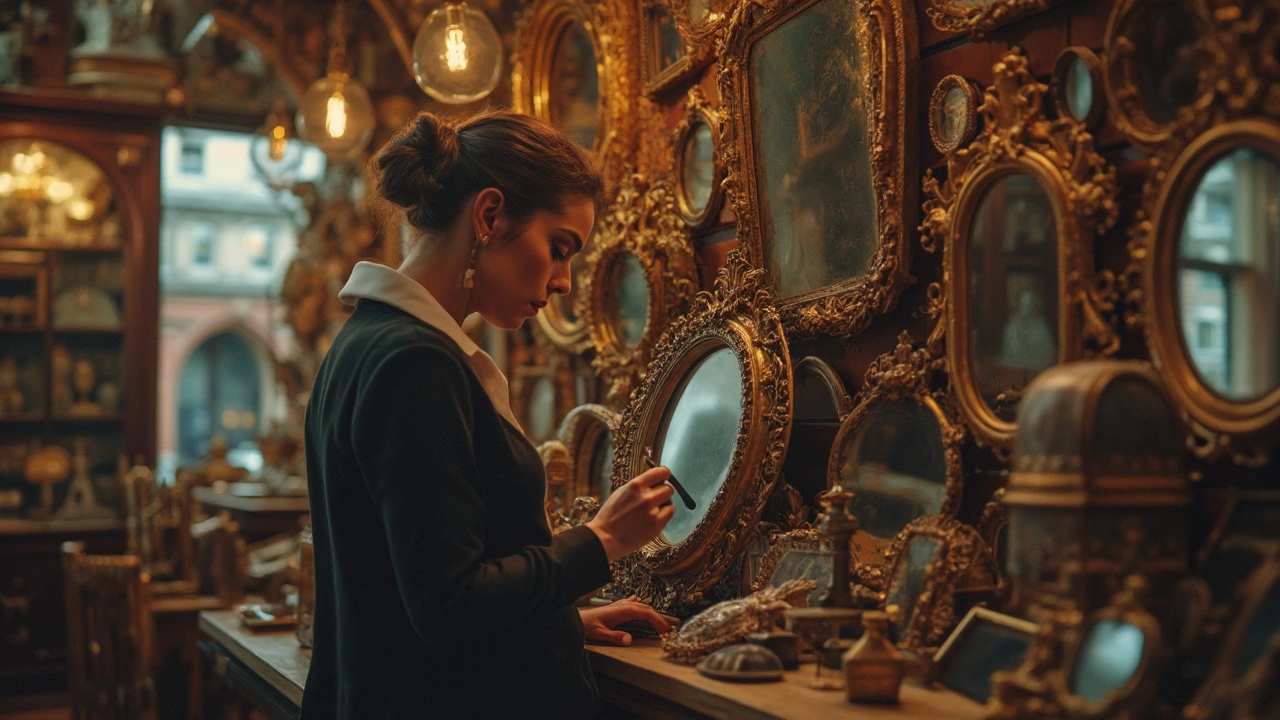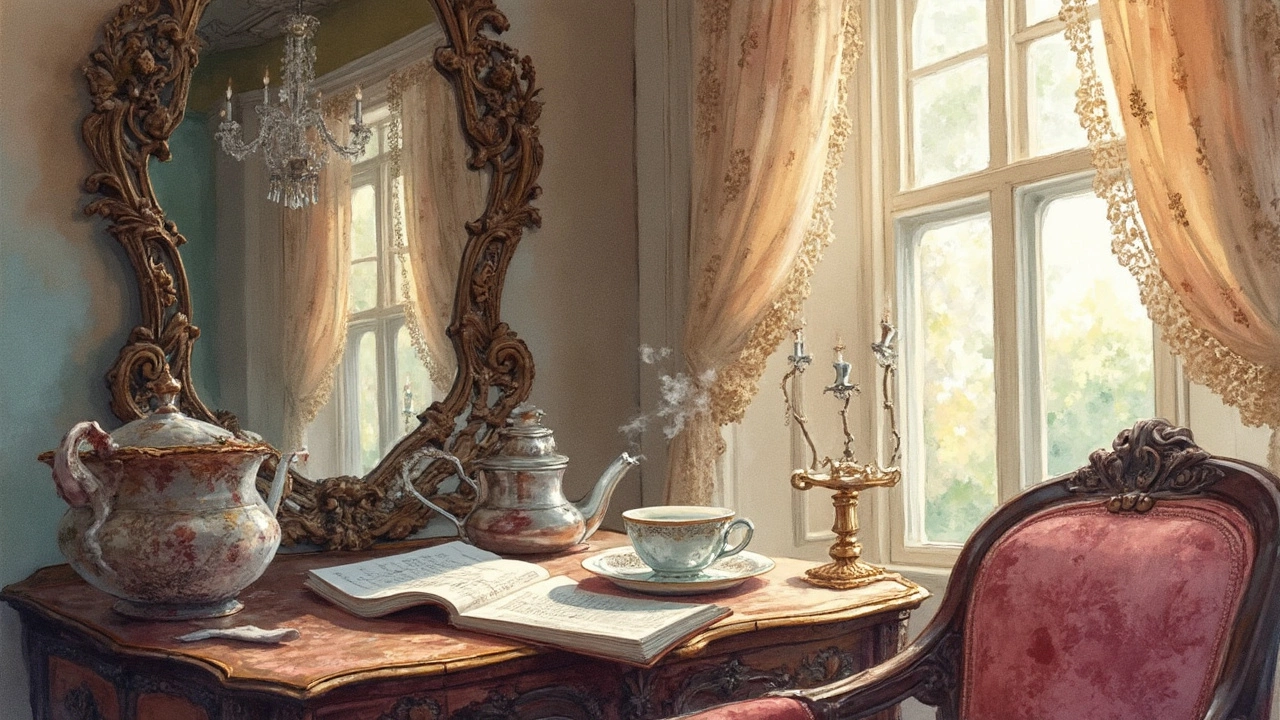How to Identify a Vintage Mirror: Spotting Antique Mirrors Like a Pro
 Jun, 26 2025
Jun, 26 2025
Not every dusty-looking mirror hanging in Grandma's hallway is actually vintage. Sometimes, what seems just old is, well, just old—while the real hidden gems might sit unnoticed in a thrift store or even your own attic. The market for authentic vintage mirrors is hot, with collectors, decorators, and DIY fanatics all racing to find the real deal. It’s not just about adding charm, either. Vintage mirrors carry history, craftsmanship, and even quirks that you’ll never see on a modern piece from the local home goods store. But how do you tell a priceless antique from a cleverly aged dupe? Let’s get into the nitty-gritty details, because the clues you need are probably right in front of your nose—sometimes literally.
Decoding the Physical Clues: Aging, Glass, and Backing
When I first caught the vintage mirror bug, my wife Elena gave me that know-it-all grin she reserves for my most random obsessions. She’s got a sharp eye, but I soon learned a lot outpaces good instincts. Mirrored glass has changed a ton throughout history—modern mirrors are made by coating glass with a thin layer of aluminum, but old-school versions used mercury, tin, or even silver. This isn’t just trivia. It affects everything from the mirror’s weight to its flaws.
If you ever get your hands on what you think might be a vintage mirror, start with the back and edges. The way the mirror is attached to its frame, the material of the backing, and the signs of wear can be super telling. Older mirrors, especially those made before the 1900s, often have wood backing—sometimes rough, irregular planks, not the pressed plywood you find today. The nails might be handmade and a little misshapen. If you see perfectly uniform screws or stapled MDF, it’s likely something mass-produced in the last few decades. Gently (really—no judgment for being a klutz; I’ve slipped up myself) remove the mirror to peek at what holds it in.
Now, the glass itself. Vintage glass wasn’t manufactured with today’s automation, which means you can spot quirks: faint waves, air bubbles, odd ripples, and areas where the reflection bends. Antique mirrors often have what collectors call "foxing"—those cloudy, speckled black or brown spots that spread on the silver backing after years of reacting with air and moisture. If you spot foxing in a random shape (not just around the edges), that’s a pretty solid feint. Modern manufacturing can artificially age mirrors for decoration, but these forgeries usually don’t get all the details right: the foxing looks too uniform or obviously stenciled.
Peel back the sticker or any paper attached to the backing. Old mirrors sometimes have manufacturer stamps, marks, or dates. Early American glassmakers loved bragging about their work, so a faint, barely legible label can suddenly make that dusty piece a star of the show. Examine closely with a flashlight—sometimes, the dates have rubbed off but the shadow of the ink remains.
Frame Finishes, Construction, and Telltale Styles
Mirrors are often remembered for their frames as much as their glass. It’s almost like a snapshot of whichever decade they were made. Ornate gilded wood screams Victorian luxury, while those chunky, geometric Art Deco numbers leave no doubt you’re in the Roaring Twenties. If you’ve seen a farmhouse-style mirror at the flea market and thought, That must be a hundred years old, pause: a quick boom in "shabby chic" reproductions during the early 2000s brought a flood of new-old designs. Real vintage frames give away their age not just by the style but the materials and wear patterns.
Check for honest wear, especially where hands would grab the mirror or where it would naturally rub against a wall. Decades of use leave smooth spots, edges worn down, or small nicks and cracks—while artificially aged pieces often have predictable, repetitive distress marks. Peer into the corners and decorative grooves for packed-in dust or even old polish residue. Don’t ignore the back—sometimes, a frame that looks gilded is actually resin coated in gold paint, a trick you’ll rarely see before the 1970s.
Classic wooden frames (especially 19th-century ones) were hand-carved, so look for tiny irregularities. These come off as less "perfect" than modern pieces—even the best craftsman’s work isn’t machine-level flawless. If you spot spots of missing gesso (the chalky underlayer that sits under gold leaf), or find old joint pegs or crude nails, you’re likely holding something special. Painted mirrors are great for this kind of detective work—layers of paint, visible brushstrokes, and the occasional hint of old colors peeking out point to an authentic past life.
Ever see those really wild, curve-heavy French mirrors? If the details are crisp all over, be suspicious—cheap modern copies tend toward shallow, repetitive moldings, often snapped onto identical frames. Real vintage mirrors have depth in their cutouts and a heft you can feel the minute you pick them up. I remember Elena dragging me to a Paris flea market, where she clocked a 1920s Louis Philippe mirror just by the way the gilded acanthus leaves curled and the weight nearly wrenched her arm out of its socket. No resin knockoff could fake that feel.

Glass Techniques, Tints, and Reflection Quality
The glass itself is the heart of every mirror—if you’ve ever taken a selfie in a truly old mirror, you’ll notice the reflection isn’t as nearly perfect as in the bathroom panels at home. Antique mirrors tend to show a slightly blurry or uneven image. It’s subtle, sometimes almost romantic. That slight "smokiness" or a gentle gold-and-silvery tone in the reflection? Early glassmaking methods (like cylinder or crown glass) didn’t produce the razor-sharp clarity of today’s float glass. Look from different angles and under different light (trust me, bring your phone flashlight or ask a vendor to move the mirror toward a window).
Colors count. Some vintage mirrors have a faint, dreamy amber or grey tint—totally natural to their period. If you see a hint of green, that's often post-1940s glass due to certain manufacturing tricks. Test the sharpness of the reflection: Stick your finger up to the glass and look for the gap between your fingertip and its reflection. In older mirrors, the gap can be slightly more pronounced, but this is a rough trick—the thickness of the glass and how it was cut also affect the outcome. Combine this with what you see about the frame and backing for the full picture.
Some vintage pieces were "beveled," meaning the edges of the glass are sloped. This was usually done by hand, resulting in slightly uneven bevels. Newer, machine-made beveled mirrors look clinical and exact. My son Dorian, who’s into math, once measured the edge widths for fun—and sure enough, the wobbly ones were on our true vintage finds.
Keep an eye out for warping. It’s common in older mirrors for the glass sheet to subtly bend over time, making reflections look like you’re in one of those funhouse attractions. It’s easy to spot if you look along the long axis of the mirror, especially with a door frame or straight line in the background. Don’t confuse this with cheap glass, though—the mix of physical age, framing, and reflective quirks marks a seasoned vintage mirror, not just a factory mishap.
Ever noticed the small, almost invisible dots or silver lines running along one edge? Sometimes these are from the old "mercury glass" process. If a mirror smells a bit metallic when you rub the back, and you see swirly silver losses, you’ve got a big clue. But take care—mercury is hazardous, and old mirrors like this can chip easily.
Research, Documentation, and Spotting Reproductions
Fingerprints and foxing can tell you a lot, but nothing beats proper detective work. If you unearth a mirror in a yard sale or thrift shop, don't be shy about asking questions. Sometimes, families pass mirrors down for generations, and stories (even with a bit of exaggeration from Grandpa) can clue you in on an object’s past. But don’t just take their story at face value—use documentation where possible. If there’s a manufacturer’s mark, pull out your phone and search. Cross-reference the company and date ranges.
Look for catalog scans or books featuring mirrors from similar periods—sites like The Met, Victoria & Albert Museum, or specialty antique forums often post detailed write-ups and photos. Compare style, proportions, and glass qualities. Auction records are gold here. If shops have similar-looking mirrors all labeled “vintage,” that’s a red flag for reproductions.
Before the industrial revolution, mirrors were expensive and rare. If your supposed “18th-century” mirror has perfect clarity, no foxing, and MDF backing, you’re holding a fancy modern remake. Early- to mid-20th-century design reproductions are everywhere now—especially Art Deco and Hollywood Regency styles. Manufacturers often used cheaper materials (laminated wood, plastic gesso) and stuck on decorative details. Flip the mirror around to spot seams or join marks that wouldn’t be there in a true vintage piece. Smell is a weird but valid test—genuine antique wood frames tend to keep a musty, old-wood scent, not the sharp glue-and-resin punch of new frames.
If you’re thinking of dropping some real cash on a “vintage” mirror, ask for provenance or expert appraisal. Professional appraisers can spot tiny details typical of specific eras. Ask for closeups of the frame corners, backing, and glass, especially under natural light.
One last thing: not every piece has to be a museum relic. The magic of vintage mirrors comes from how they mix visual interest, a bit of history, and a dash of human imperfection. The next time you’re considering a new find for your dining room, keep these tricks in mind, and soon, you’ll be the one wowing your friends with your eye for real vintage—maybe you’ll even stumble onto a treasure to pass down to your own Dorian or Selena.